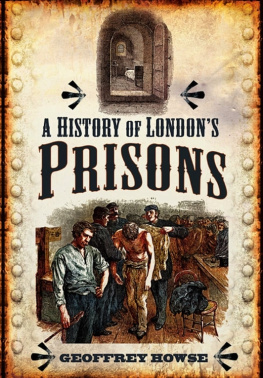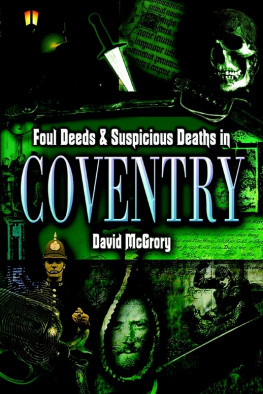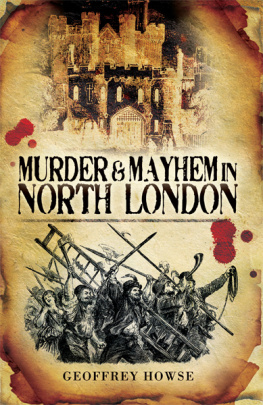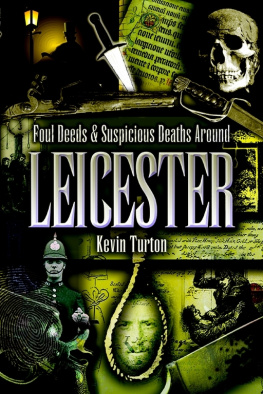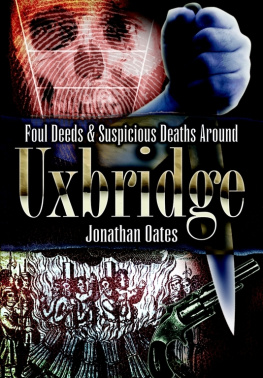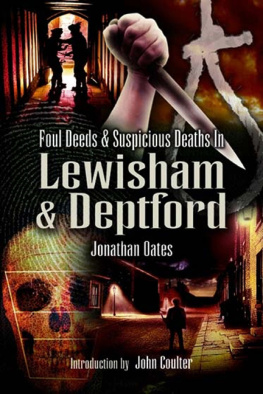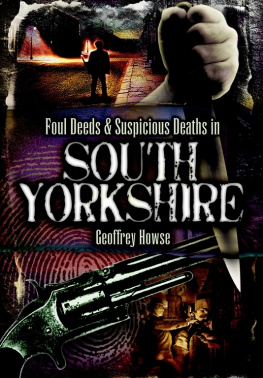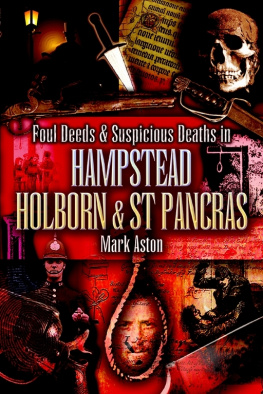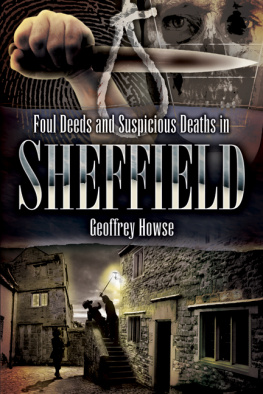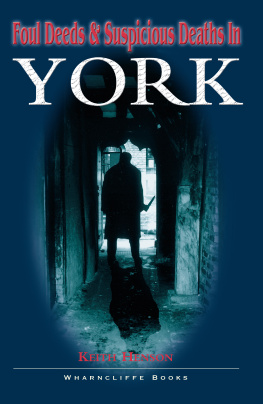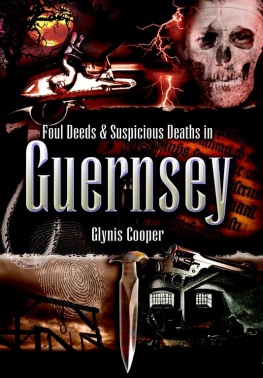FOUL DEEDS AND SUSPICIOUS DEATHS Series
Wharncliffes Foul Deeds and Suspicious Deaths series explores, in detail, crimes of passion, brutal murders and foul misdemeanours from early modern times to the present day. Victorian street crime, mysterious death and modern murders tell tales where passion, jealousy and social deprivation brought unexpected violence to those involved. From unexplained death and suicide to murder and manslaughter, the books provide a fascinating insight into the lives of both victims and perpetrators as well as society as a whole.
Other titles in the series include:
Foul Deeds and Suspicious Deaths in Birmingham , Nick Billingham
ISBN: 1-903425-96-4. 10.99
Foul Deeds and Suspicious Deaths in Bolton , Glynis Cooper
ISBN: 1-903425-63-8. 9.99
Foul Deeds and Suspicious Deaths in Colchester , Patrick Denney
ISBN: 1-903425-80-8. 10.99
Foul Deeds and Suspicious Deaths in Coventry , David McGrory
ISBN: 1-903425-57-3. 9.99
Foul Deeds and Suspicious Deaths Around Derby , Kevin Turton
ISBN: 1-903425-76-x. 9.99
Foul Deeds and Suspicious Deaths in & around Durham , Maureen Anderson
ISBN: 1-903425-46-8. 9.99
Foul Deeds and Suspicious Deaths in Londons East End , Geoffrey Howse
ISBN: 1-903425-71-9. 10.99
Foul Deeds and Suspicious Deaths in Hampstead, Holburn & St Pancras , Mark Aston
ISBN: 1-903425-94-8. 10.99
Foul Deeds and Suspicious Deaths in Hull , David Goodman
ISBN: 1-903425-43-3. 9.99
Foul Deeds and Suspicious Deaths Around Leicester , Kevin Turton
ISBN: 1-903425-75-1. 10.99
Foul Deeds and Suspicious Deaths in Manchester , Martin Baggoley
ISBN: 1-903425-65-4. 9.99
Foul Deeds and Suspicious Deaths in Newcastle , Maureen Anderson
ISBN: 1-903425-34-4. 9.99
Foul Deeds and Suspicious Deaths in Newport , Terry Underwood
ISBN: 1-903425-59-X. 9.99
Foul Deeds and Suspicious Deaths in and Around Scunthorpe , Stephen Wade
ISBN: 1-903425-88-3. 9.99
More Foul Deeds and Suspicious Deaths in Wakefield , Kate Taylor
ISBN: 1-903425-48-4. 9.99
Foul Deeds and Suspicious Deaths in York , Keith Henson
ISBN: 1-903425-33-6. 9.99
Foul Deeds and Suspicious Deaths on the Yorkshire Coast , Alan Whitworth
ISBN: 1-903425-01-8. 9.99
Please contact us via any of the methods below for more information or a catalogue.
WHARNCLIFFE BOOKS
47 Church Street Barnsley South Yorkshire S70 2AS
Tel: 01226 734555 734222 Fax: 01226 734438
E-mail: enquiries@pen-and-sword.co.uk Website: www.wharncliffebooks.co.uk
Dedication
This book is dedicated to a true Londoner
Tracy P Deller
Who loves the West End
First Published in Great Britain in 2006 by
Wharncliffe Books
an imprint of
Pen and Sword Books Ltd
47 Church Street
Barnsley
South Yorkshire
S70 2AS
Copyright Geoffrey Howse 2006
ISBN: Paperback 1-84563-001-7
eISBN: 9781844682997
The right of Geoffrey Howse to be identified as Author of this Work has been asserted by him in accordance with the Copyright, Designs and Patents Act 1988.
A CIP catalogue record for this book is available from the British Library.
All rights reserved. No part of this publication may be reproduced, stored in a retrieval system, or transmitted, in any form or by any means, electronic, mechanical, photocopying, recording or otherwise, without the prior permission in writing of the publishers.
Typeset in 11/13pt Plantin by Mac Style, Nafferton, E.Yorkshire
Printed and bound in England by CPI UK.
Pen and Sword Books Ltd incorporates the Imprints of
Pen & Sword Aviation, Pen & Sword Maritime,
Pen & Sword Military, Wharncliffe Books,
Pen & Sword Select, Pen and Sword Military Classics and Leo Cooper.
For a complete list of Pen & Sword titles please contact
PEN & SWORD BOOKS LIMITED
47 Church Street
Barnsley
South Yorkshire
S70 2BR
England
E-mail: enquiries@pen-and-sword.co.uk
Website: www.pen-and-sword.co.uk
Contents

A Map of the Parish of St Pauls, Covent Garden from Stows Survey of 1755. Authors collection
Introduction
Londons West End, as distinct from West London, which is quite different in all respects (West London being those relatively modern London Boroughs to the West of the metropolis, the West End being at the heart of it), is contained within a relatively small area. The West End is not as clearly defined as that part of London popularly referred to as the Square Mile, the City of London, which has remained Londons financial district since the ancient Roman city was founded over two thousand years ago. The West End is largely situated within the other city, the City of Westminster, founded a thousand years later. The City of Westminster grew around Westminster Abbey, founded by Edward the Confessor, Saint and English King, born c. 1003, who reigned from 104266, and his palace of Westminster, now the Houses of Parliament. The West End of today lies largely within Westminster itself, and partly in the modern London Borough of Camden and the Royal Borough of Kensington and Chelsea. As well as incorporating some of the most famous theatres, hotels, shopping streets and arcades in the world, the West End has been, for centuries, the place where the monarch and other members of the Royal Family, aristocratic, noble, wealthy, fashionable and famous, usually kept a London residence. The West Ends identity has always been jealously guarded to keep it special and to distinguish it from that part of London east of the Tower of London known as the East End, which has a very distinctive character and history, but not as those from the West End would have it, as important and distinguished as their own. Whereas the East End largely grew up along the River Thames and the eleven Tower Hamlets, over many centuries, dating principally from early Norman times, the West Ends development as a fashionable area of any significance can be roughly dated to the closing decades of the sixteenth century, when the area began to be developed on a large scale and theatres and other places of entertainment became an important feature. Despite the supposed gentility of the West End, there has been a considerable amount of foul deeds perpetrated there, as you will see in the chapters that follow.
The West End consists of parts of the City of Westminster and includes Mayfair, Belgravia, parts of Victoria, Knightsbridge, Bayswater, Marylebone, Fitzrovia, Holborn and Bloomsbury, Strand, Piccadilly, St Jamess, Adelphi, St Giles, St Martins, Soho and Covent Garden. Within these areas are other smaller districts which have their own individual characters. The present day Oxford Street, formerly known as Tyburn Road, could be said to bisect the West End but not quite in equal portions. It was along this thoroughfare that condemned prisoners were brought on their way to be executed at Tyburn, situated where Edgeware Road meets Oxford Street in the vicinity of Marble Arch.
Within the pages of this book you will find many references to Tyburn and to prisoners being drawn to their executions there. To clarify what drawing actually meant and to avoid confusion, here is a brief explanation. There were three kinds of drawing. In the vast majority of cases drawing means dragging to the place of execution, where hanging disemboweling and quartering followed. But drawing sometimes means dragging till the sufferer died of the mere dragging. In some cases drawing means tugging by horses in opposite directions till the sufferer was torn to pieces. Drawing in any of its forms appears to have been extremely unpleasant, and usually had only one outcome, death.




